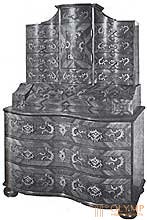
Style (French. Rococo), rokail (from the ornamental motive rokail), developed in European plastic arts 1st floor. 18th century  It arose in France during the crisis of absolutism, reflecting the hedonistic attitudes peculiar to the aristocracy, the flight to escape from the illusory and idyllic world of theatrical play. The architecture influenced mainly the character of the decor, which acquired a pretentiously refined, emphasized elegant and sophisticated look.
It arose in France during the crisis of absolutism, reflecting the hedonistic attitudes peculiar to the aristocracy, the flight to escape from the illusory and idyllic world of theatrical play. The architecture influenced mainly the character of the decor, which acquired a pretentiously refined, emphasized elegant and sophisticated look. 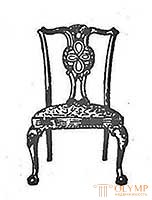 In the early period of development of the French Rococo (until about 1725), fractional ornamentation was introduced into the decoration of the rooms, and the objects of the situation were given intricately curved shapes (the so-called regency style). The developed Rococo (approximately 1725–50) widely used carved and stucco patterns, curls, broken cartouches, rokaili, cupids-head masks, etc .; in the decoration of the rooms, reliefs and picturesque panels in exquisite frames (decade ports, etc.), as well as numerous mirrors that enhanced the effect of light movement (the so-called Louis XV style) played a large role.
In the early period of development of the French Rococo (until about 1725), fractional ornamentation was introduced into the decoration of the rooms, and the objects of the situation were given intricately curved shapes (the so-called regency style). The developed Rococo (approximately 1725–50) widely used carved and stucco patterns, curls, broken cartouches, rokaili, cupids-head masks, etc .; in the decoration of the rooms, reliefs and picturesque panels in exquisite frames (decade ports, etc.), as well as numerous mirrors that enhanced the effect of light movement (the so-called Louis XV style) played a large role. 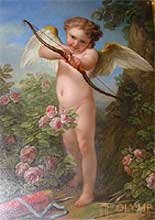 The ornament, the orientation of the Rococo style has limited its influence on the tectonics and appearance of structures. The architecture of the French hotels (architects J.M. Oppenor, J.O. Mason, J.Bofran, and others) lavishly decorated rocaille interiors combined with the relative, severity of the exterior.
The ornament, the orientation of the Rococo style has limited its influence on the tectonics and appearance of structures. The architecture of the French hotels (architects J.M. Oppenor, J.O. Mason, J.Bofran, and others) lavishly decorated rocaille interiors combined with the relative, severity of the exterior. 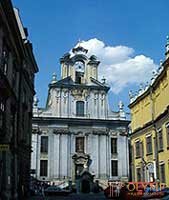 Spreading in the architecture of European countries (Germany (G. V. Knobelsdorf, I. B. Neumann, partly M. D. Pöppelman), Austria, Poland, Czechoslovakia), the rococo style was often a kind of local late baroque style.
Spreading in the architecture of European countries (Germany (G. V. Knobelsdorf, I. B. Neumann, partly M. D. Pöppelman), Austria, Poland, Czechoslovakia), the rococo style was often a kind of local late baroque style.
Chamber-like gallant scenes, erotic-mythological and pastoral scenes, asymmetrical compositions are characteristic of painting, sculpture and Rococo graphics. The rococo sculpture was dominated by reliefs and statues intended for interior decoration, small figurines, groups, busts, including from terracotta, painted or unglazed porcelain (J. B. Lemoine in France, I. I. Candler in Germany). The rocail art is rich in subtle modulations and somewhat faded in color (its stylistic features were influenced in many ways by A. Watteau’s decorative refinement, aesthetic 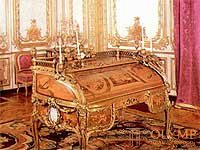 The content of which, however, goes far beyond the ideological and artistic framework of Rococo) also had a predominantly decorative character (French masters N. Lancre, F. Lemoine, J. M. Nattier, F. Boucher, partly J. O. Fragonard). The capricious elegance of the decoration, often combined with the borrowing of exotic motifs of Chinese art, is characteristic of the works of decorative and applied art of Rococo, whose masters were able to subtly reveal the expressive possibilities of the material.
The content of which, however, goes far beyond the ideological and artistic framework of Rococo) also had a predominantly decorative character (French masters N. Lancre, F. Lemoine, J. M. Nattier, F. Boucher, partly J. O. Fragonard). The capricious elegance of the decoration, often combined with the borrowing of exotic motifs of Chinese art, is characteristic of the works of decorative and applied art of Rococo, whose masters were able to subtly reveal the expressive possibilities of the material.
Since the 1760s. Rococo style is everywhere supplanted by classicism. In Russia, the rococo trends, especially strong in the middle of the 18th century, were manifested mainly in the decoration of palace interiors (including those created by V. V. Rastrelli), stucco decoration of buildings, and in a number of branches of decorative and applied arts (wood carving, artistic silver and porcelain, furniture, jewelry art).
Что бы оставить комментарий войдите
Комментарии (0)